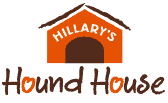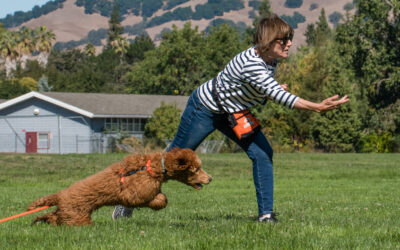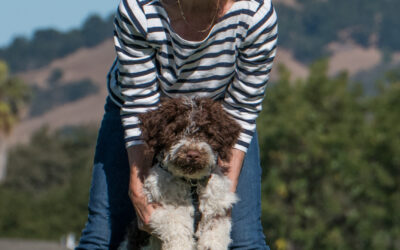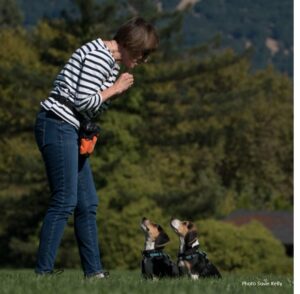 When you have an opportunity to introduce your pup to a new dog, I suggest you take a moment to assess the situation. I always ask the owner if their dog really enjoys puppies. This surprises a lot of people. I mean, who doesn’t like puppies? As it happens, many adult dogs find puppies annoying and can take them or leave them (usually the latter). How come? The short answer is puppies have sharp teeth and nails, no impulse control and don’t take, “No!” for an answer when they get excited. Which for gregarious puppies is most of the time around a new dog.
When you have an opportunity to introduce your pup to a new dog, I suggest you take a moment to assess the situation. I always ask the owner if their dog really enjoys puppies. This surprises a lot of people. I mean, who doesn’t like puppies? As it happens, many adult dogs find puppies annoying and can take them or leave them (usually the latter). How come? The short answer is puppies have sharp teeth and nails, no impulse control and don’t take, “No!” for an answer when they get excited. Which for gregarious puppies is most of the time around a new dog.
“The sad fact is that young puppies miss the subtle social cues dogs gives to indicate they aren’t interested in an encounter.”
The sad fact is that young puppies miss the subtle social cues dogs gives to indicate they aren’t interested in an encounter. In most cases it’s full steam ahead, damn the torpedoes, and by the time a puppy arrives that adult dog is growing irritated, possibly angry. If he’s on a leash he has few options but to become visibly angry and perhaps snap. I feel for both – the puppy that rushes in and ends up scolded or worse, and an older dog that would rather head for the hills than get mobbed by a puppy.
“My own rule is that I never approach a dog with a puppy unless I know and have full control of the dog. It’s the safest way to ensure that a meeting will go well.”
Many puppy owners – especially new ones have no clue how to introduce their puppy safely to a strange dog. My own rule is that I never approach a dog with a puppy unless I know and have full control of both. It’s the safest way to ensure a puppy’s safety.
“Word to the wise; If you’re unsure, walk away.”
So what to do when your puppy gets excited at the prospect of meeting a new dog? Word to the wise; If you’re unsure, walk away. I don’t mean to sound harsh – simply realistic. If I sense a dog is less than willing to meet my puppy, whether that puppy is shy, lacks confidence, social skills, or is rambunctious I wave politely and move on. I could be wrong – the dog that is becoming stiff, looking or turning away, yawning or licking his lips might love to meet my puppy (highly unlikely as these behaviors do not signal a willingness for the encounter). Or I could be right (as I am 90% of the time) and it’s not worth tormenting an older or disinterested dog with an over-enthusiastic puppy. I have a soft spot for older dogs. It’s no more their job to instruct or discipline my puppy than the stranger in the next car.
“While I’m not a mind reader, I do know that dogs take their body language seriously. In fact, if we take a moment to look, they speak volumes about their state of mind and willingness to meet a puppy. The thing to remember is your puppy will probably not recognize what they are trying to say.”
 A useful question to ask is, “What’s going through a dog’s head when a puppy gets out of line or is rude?” While I’m not a mind reader, I do know that dogs take their body language seriously. In fact, if we take a moment to watch a dog’s body language it will speak volumes about their state of mind and willingness to meet a puppy. The thing to remember is your puppy may not recognize the signs that it’s time to leave.
A useful question to ask is, “What’s going through a dog’s head when a puppy gets out of line or is rude?” While I’m not a mind reader, I do know that dogs take their body language seriously. In fact, if we take a moment to watch a dog’s body language it will speak volumes about their state of mind and willingness to meet a puppy. The thing to remember is your puppy may not recognize the signs that it’s time to leave.
This is why it’s up to us to teach them, especially when we can save both a dog and our puppy from making a major social faux pas, one that might become scary or even dangerous.
Teaching your puppy to walk away from a strange dog instead of barging into his personal space is a powerful lesson in self-control. Taking that decision away from a puppy teaches him an important lesson about not charging up to strange dogs – even if he doesn’t see it that way at the moment. I promise you, it won’t be long before he does see the wisdom in it. In fact by the age of two, the vast majority of dogs lose the urge to approach strangers and prefer the company of familiar dogs and family.
A Safe Way to Introduce Puppies to New Dogs
If you have an opportunity to introduce your puppy to a dog you know, a nice way to proceed is to have what I call a “Cool-out” moment. This is when I pull out treats and have a puppy and the dog sit on either side of me and wait for a treat. I hand them out to both, encouraging each to look into my eyes and relax. This shows my friend’s dog I’ve got this – and this puppy isn’t a complete barbarian. He’s got some skills. Most dogs find this reassuring. Sitting for treats is familiar and it’s nice to know a puppy speaks that language, too.
Having both your puppy and the dog sit with some distance between them also gives the dog an opportunity to walk away if he wishes. Or he could stay and wait for the signal to meet and have a sniff. If a dog does leave, it’s important to keep your puppy with you and respect their wishes. This models for your puppy what respect looks like and how to show it.
“Pausing before rushing in gives your puppy and the other dog a chance to watch each other and indicate their readiness for an encounter.”
Pausing before rushing in gives both your puppy and the other dog a chance to watch each other and indicate their readiness for an encounter. I might even stay about ten feet away in a, “cooler orbit,” and work with a puppy before coming over.
Relaxed Encounters Instruct Puppies and Reassure Dogs
If there’s time for a relaxed encounter, you can even hang out a little before the encounter. Many shy or cautious puppies prefer to hang back and observe. Safety is more important to these puppies than an encounter. For excitable puppies this is a breather to help them relax.
If your puppy can relax in the presence of another dog there’s an even better chance that dog might be open to meeting him. Which brings me to an important training tip, one that all puppy owners should learn right away. Watch the other dog.
Watch the Other Dog
There is no foolproof way to predict what dog will do when he meets your puppy, but there’s still a lot of information you can glean from taking a moment to observe a dog’s facial expressions and body language. Here are some things to look for;
- Does he seem calm, relaxed, and receptive?
- Does he give a play bow?
- Is his spine relaxed and fluid, his eyes and expression, soft?
- On the other hand, is he looking or turning away, yawning, or blinking?
- Is he standing stiffly in place (or on leash)?
- Is he staring unblinkingly at your puppy?
- Is his tail rigid or waving stiffly?
- Does he try to walk away, or try to even if he’s on a leash?
- Is he moving past or walking sideways while staring at your puppy?
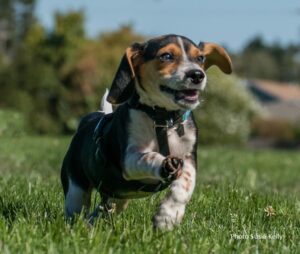 If you see anything from number 4 onward, walk on by.
If you see anything from number 4 onward, walk on by.
What if your puppy is too excited and begins to pull, lunge or bark? Odds are his excitement will increase the closer you get. You might want to ask yourself, if I was an older dog would I want to deal with this whirling dervish with sharp teeth and claws coming at me? Personally, I’d head for the hills and this is the choice of the majority of older dogs. Better to move on and create a calm encounter where you can control all the variables.
Up Next: The Importance of Moderating and Supervising Your Puppy’s Play
